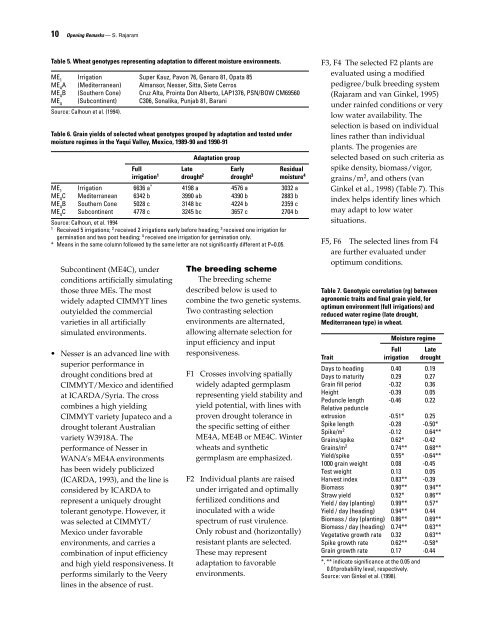Septoria and Stagonospora Diseases of Cereals - CIMMYT ...
Septoria and Stagonospora Diseases of Cereals - CIMMYT ...
Septoria and Stagonospora Diseases of Cereals - CIMMYT ...
Create successful ePaper yourself
Turn your PDF publications into a flip-book with our unique Google optimized e-Paper software.
10 Opening Remarks — S. Rajaram<br />
Table 5. Wheat genotypes representing adaptation to different moisture environments.<br />
ME1 ME4A ME4B ME4 Irrigation<br />
(Mediterranean)<br />
(Southern Cone)<br />
(Subcontinent)<br />
Super Kauz, Pavon 76, Genaro 81, Opata 85<br />
Almansor, Nesser, Sitta, Siete Cerros<br />
Cruz Alta, Prointa Don Alberto, LAP1376, PSN/BOW CM69560<br />
C306, Sonalika, Punjab 81, Barani<br />
Source: Calhoun et al. (1994).<br />
Table 6. Grain yields <strong>of</strong> selected wheat genotypes grouped by adaptation <strong>and</strong> tested under<br />
moisture regimes in the Yaqui Valley, Mexico, 1989-90 <strong>and</strong> 1990-91<br />
Full Late<br />
Adaptation group<br />
Early Residual<br />
irrigation1 drought2 drought3 moisture4 ME1 Irrigation 6636 a * ME4C ME4B ME4C Mediterranean<br />
Southern Cone<br />
Subcontinent<br />
6342 b<br />
5028 c<br />
4778 c<br />
4198 a<br />
3990 ab<br />
3148 bc<br />
3245 bc<br />
4576 a<br />
4390 b<br />
4224 b<br />
3657 c<br />
3032 a<br />
2883 b<br />
2359 c<br />
2704 b<br />
Source: Calhoun, et al. 1994<br />
1 Received 5 irrigations; 2 received 2 irrigations early before heading; 3 received one irrigation for<br />
germination <strong>and</strong> two post heading; 4 received one irrigation for germination only.<br />
* Means in the same column followed by the same letter are not significantly different at P=0.05.<br />
Subcontinent (ME4C), under<br />
conditions artificially simulating<br />
those three MEs. The most<br />
widely adapted <strong>CIMMYT</strong> lines<br />
outyielded the commercial<br />
varieties in all artificially<br />
simulated environments.<br />
• Nesser is an advanced line with<br />
superior performance in<br />
drought conditions bred at<br />
<strong>CIMMYT</strong>/Mexico <strong>and</strong> identified<br />
at ICARDA/Syria. The cross<br />
combines a high yielding<br />
<strong>CIMMYT</strong> variety Jupateco <strong>and</strong> a<br />
drought tolerant Australian<br />
variety W3918A. The<br />
performance <strong>of</strong> Nesser in<br />
WANA’s ME4A environments<br />
has been widely publicized<br />
(ICARDA, 1993), <strong>and</strong> the line is<br />
considered by ICARDA to<br />
represent a uniquely drought<br />
tolerant genotype. However, it<br />
was selected at <strong>CIMMYT</strong>/<br />
Mexico under favorable<br />
environments, <strong>and</strong> carries a<br />
combination <strong>of</strong> input efficiency<br />
<strong>and</strong> high yield responsiveness. It<br />
performs similarly to the Veery<br />
lines in the absence <strong>of</strong> rust.<br />
The breeding scheme<br />
The breeding scheme<br />
described below is used to<br />
combine the two genetic systems.<br />
Two contrasting selection<br />
environments are alternated,<br />
allowing alternate selection for<br />
input efficiency <strong>and</strong> input<br />
responsiveness.<br />
F1 Crosses involving spatially<br />
widely adapted germplasm<br />
representing yield stability <strong>and</strong><br />
yield potential, with lines with<br />
proven drought tolerance in<br />
the specific setting <strong>of</strong> either<br />
ME4A, ME4B or ME4C. Winter<br />
wheats <strong>and</strong> synthetic<br />
germplasm are emphasized.<br />
F2 Individual plants are raised<br />
under irrigated <strong>and</strong> optimally<br />
fertilized conditions <strong>and</strong><br />
inoculated with a wide<br />
spectrum <strong>of</strong> rust virulence.<br />
Only robust <strong>and</strong> (horizontally)<br />
resistant plants are selected.<br />
These may represent<br />
adaptation to favorable<br />
environments.<br />
F3, F4 The selected F2 plants are<br />
evaluated using a modified<br />
pedigree/bulk breeding system<br />
(Rajaram <strong>and</strong> van Ginkel, 1995)<br />
under rainfed conditions or very<br />
low water availability. The<br />
selection is based on individual<br />
lines rather than individual<br />
plants. The progenies are<br />
selected based on such criteria as<br />
spike density, biomass/vigor,<br />
grains/m 2 , <strong>and</strong> others (van<br />
Ginkel et al., 1998) (Table 7). This<br />
index helps identify lines which<br />
may adapt to low water<br />
situations.<br />
F5, F6 The selected lines from F4<br />
are further evaluated under<br />
optimum conditions.<br />
Table 7. Genotypic correlation (rg) between<br />
agronomic traits <strong>and</strong> final grain yield, for<br />
optimum environment (full irrigations) <strong>and</strong><br />
reduced water regime (late drought,<br />
Mediterranean type) in wheat.<br />
Moisture regime<br />
Full Late<br />
Trait irrigation drought<br />
Days to heading 0.40 0.19<br />
Days to maturity 0.29 0.27<br />
Grain fill period -0.32 0.36<br />
Height -0.39 0.05<br />
Peduncle length<br />
Relative peduncle<br />
-0.46 0.22<br />
extrusion -0.51* 0.25<br />
Spike length -0.28 -0.50*<br />
Spike/m2 -0.12 0.64**<br />
Grains/spike 0.62* -0.42<br />
Grains/m2 0.74** 0.68**<br />
Yield/spike 0.55* -0.64**<br />
1000 grain weight 0.08 -0.45<br />
Test weight 0.13 0.05<br />
Harvest index 0.83** -0.39<br />
Biomass 0.90** 0.94**<br />
Straw yield 0.52* 0.86**<br />
Yield / day (planting) 0.99** 0.57*<br />
Yield / day (heading) 0.94** 0.44<br />
Biomass / day (planting) 0.86** 0.69**<br />
Biomass / day (heading) 0.74** 0.63**<br />
Vegetative growth rate 0.32 0.63**<br />
Spike growth rate 0.62** -0.58*<br />
Grain growth rate 0.17 -0.44<br />
*, ** indicate significance at the 0.05 <strong>and</strong><br />
0.01probability level, respectively.<br />
Source: van Ginkel et al. (1998).









